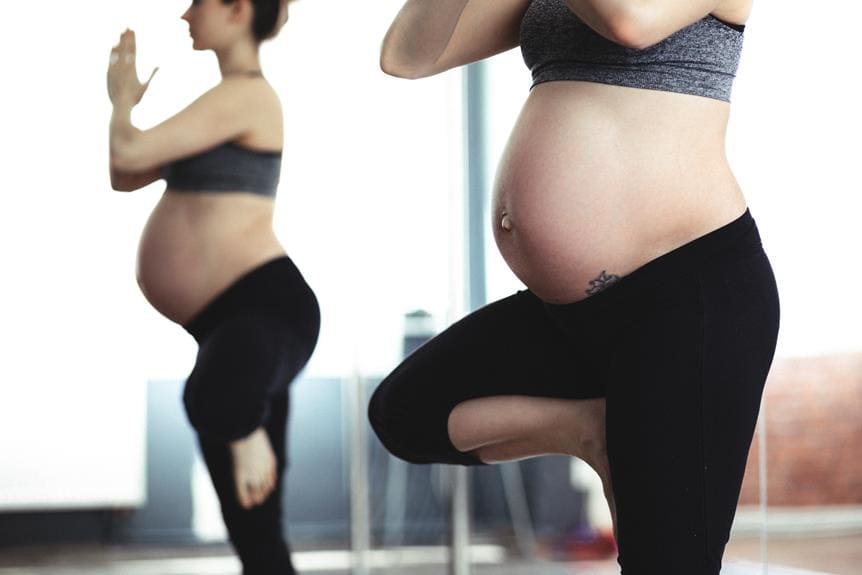How to Stay Fit and Active During Pregnancy

According to recent studies, staying active and fit during pregnancy not only benefits the expectant mother, but also enhances the health and well-being of the developing baby. With this in mind, it is crucial for pregnant women to engage in safe and effective exercise routines.
This article will provide valuable insights and practical tips on how to maintain a healthy lifestyle during pregnancy. These include prenatal yoga, low-impact cardiovascular exercises, strength training, balanced diet, swimming, and relaxation techniques.
By prioritizing self-care, expectant mothers can ensure a healthier and more enjoyable pregnancy journey.
Key Takeaways
- Exercise benefits both physical and mental well-being of expectant mothers
- Walking, stretching, prenatal yoga, swimming, and stationary cycling are safe and effective exercises during pregnancy
- Modifications should be made to accommodate changes in the body during pregnancy
- Prenatal exercise enhances overall well-being, maintains optimal health, strengthens pelvic floor muscles, improves posture, and alleviates common discomforts
Understanding the Benefits of Exercise During Pregnancy
One of the key aspects to consider when discussing the benefits of exercise during pregnancy is the impact it can have on both the physical and mental well-being of expectant mothers.
Walking during pregnancy is an excellent form of exercise that offers numerous benefits. Not only is it a low-impact activity that can be easily incorporated into daily routines, but it also helps improve cardiovascular health, strengthens muscles, and promotes weight management. Walking can also help alleviate common pregnancy discomforts such as back pain and swelling.
Additionally, stretching during pregnancy is crucial for maintaining flexibility, reducing muscle tension, and preventing injuries. Regular stretching exercises can improve posture, enhance circulation, and promote relaxation.
Overall, incorporating walking and stretching into a pregnancy fitness routine can contribute to a healthier and more enjoyable pregnancy experience.
Safe and Effective Prenatal Yoga Routines
Prenatal yoga can be a safe and effective way for pregnant women to stay active and maintain their fitness during pregnancy. It offers numerous benefits such as improved flexibility, reduced stress, and enhanced relaxation.
However, it is important to make modifications to the yoga routine to accommodate the changes in the body during pregnancy and ensure the safety of both the mother and the baby.
Prenatal Yoga Benefits
Several scientific studies have shown that engaging in regular prenatal yoga sessions can significantly improve flexibility, reduce pregnancy discomfort, and enhance overall well-being for expectant mothers. Prenatal yoga modifications are specifically designed to accommodate the changes in a pregnant woman's body, making it a safe and effective form of exercise during pregnancy.
Here are three key benefits of prenatal exercise:
- Improved flexibility: Prenatal yoga helps to stretch and strengthen the muscles, ligaments, and joints, keeping them flexible and reducing the risk of injury. This can be especially beneficial during labor and delivery.
- Reduced pregnancy discomfort: Prenatal yoga can alleviate common pregnancy discomforts such as back pain, swollen ankles, and sciatica. Gentle stretches and poses help to relieve tension and promote relaxation.
- Enhanced overall well-being: Engaging in prenatal yoga can improve mood, reduce stress and anxiety, and promote better sleep. It also helps to increase energy levels, which is essential for expectant mothers who often experience fatigue.
Modifications for Pregnancy
Two key modifications for pregnancy that should be incorporated into prenatal yoga routines are adjusting the intensity level and avoiding certain poses that may put strain on the abdomen or pelvic region. It is important to prioritize exercise safety during pregnancy to ensure the well-being of both the mother and the baby.
Pregnancy modifications in yoga should focus on maintaining a comfortable and safe practice. This includes reducing the intensity of the workout to prevent overheating and exhaustion. Additionally, certain poses that involve deep twists, inversions, or lying flat on the back should be avoided to avoid putting unnecessary strain on the abdomen or pelvic region.
Recommended Yoga Poses
To enhance flexibility and promote relaxation during pregnancy, incorporating gentle stretches and modified poses into a prenatal yoga routine is highly recommended.
Prenatal yoga provides numerous benefits for expectant mothers, including improved strength, reduced pregnancy discomfort, and increased overall well-being.
Here are three recommended yoga poses and modifications that can be safely practiced during pregnancy:
- Cat-Cow Pose: This gentle spinal movement helps alleviate back pain and improves posture. Modify by keeping the movements slow and controlled, and avoid deep rounding or arching of the back.
- Supported Warrior II: This modified version of the warrior II pose helps strengthen the legs and improve balance. Place a chair or wall nearby for support and stability while maintaining the alignment of the hips and shoulders.
- Child's Pose: This resting pose helps alleviate fatigue and stress. Use props such as blankets or bolsters to support the belly and make it more comfortable.
Incorporating these yoga modifications into a prenatal routine can provide expectant mothers with physical and mental benefits, promoting a healthier and more enjoyable pregnancy journey.
Low-Impact Cardiovascular Exercises for Expectant Mothers
Pregnant women can benefit from incorporating low-impact cardiovascular exercises, such as swimming and stationary cycling, into their fitness routines to maintain a healthy level of physical activity. These exercises provide numerous benefits, including improved cardiovascular health, increased stamina, and better weight management during pregnancy.
Maintaining a healthy weight during pregnancy is crucial for both the mother and the baby. It can help prevent complications such as gestational diabetes, high blood pressure, and excessive weight gain. Low-impact exercises are a safe and effective way to achieve this goal.
Here is a table showcasing some popular low-impact cardiovascular exercises for expectant mothers:
| Exercise | Benefits | |
|---|---|---|
| Mind | Body | Spirit |
| Reduces stress | Increases energy | Promotes relaxation |
| Improves mental clarity | Enhances circulation | Boosts self-confidence |
| Promotes better sleep | Helps with weight management | Increases feelings of well-being |
| Provides a sense of calm | Improves posture and balance | Enhances connection with baby |
| Helps to manage anxiety | Reduces swelling and bloating | Boosts overall mood |
Incorporating prenatal swimming and water aerobics into a fitness routine can not only have physical benefits, but also provide emotional support for expectant mothers. It is important to consult with a healthcare professional before starting any exercise regimen during pregnancy to ensure safety and to tailor the exercises to individual needs.
Incorporating Relaxation Techniques Into Your Fitness Routine
While maintaining an active fitness routine during pregnancy is important, it is equally crucial to incorporate relaxation techniques to promote overall well-being and reduce stress levels. Pregnancy can be a time of heightened emotions and physical changes, making it essential to prioritize self-care and mindfulness practices.
Here are three effective relaxation techniques that can be incorporated into your fitness routine:
- Deep breathing exercises: Taking slow, deep breaths can help relax your body and calm your mind. Practice deep belly breathing by inhaling deeply through your nose, holding for a few seconds, and exhaling slowly through your mouth.
- Progressive muscle relaxation: This technique involves tensing and then releasing each muscle group in your body, starting from your toes and working your way up to your head. This can help relieve tension and promote a sense of relaxation.
- Guided imagery: Visualize yourself in a peaceful and serene environment, such as a beach or a forest. Engage your senses and imagine the sights, sounds, and smells of this place. This practice can help transport your mind to a calm state and reduce stress.
Incorporating these relaxation techniques into your fitness routine can provide numerous benefits for both your physical and mental well-being during pregnancy. By nurturing your mind and body, you can better serve yourself and your growing baby.
Frequently Asked Questions
Can I Continue My Regular Exercise Routine During Pregnancy?
Yes, it is generally safe and beneficial to continue your regular exercise routine during pregnancy. However, it is important to consult with your healthcare provider to ensure that there are no potential risks or modifications needed for your specific situation.
Are There Any Specific Exercises I Should Avoid During Pregnancy?
During pregnancy, it is important to seek professional guidance regarding exercise. There are specific exercises that should be avoided to ensure the safety of both the mother and baby.
How Often Should I Exercise During Pregnancy?
During pregnancy, it is important to establish an exercise routine that is safe and beneficial. This includes understanding how to modify exercise routines and knowing the recommended frequency of exercise for pregnant women.
Can I Start a New Exercise Routine During Pregnancy?
Starting a new exercise routine during pregnancy can have numerous benefits. Engaging in regular physical activity can help maintain a healthy weight, reduce pregnancy discomfort, improve mood, and enhance overall well-being for expectant mothers.
Are There Any Specific Modifications I Should Make to My Exercise Routine as My Pregnancy Progresses?
As your pregnancy progresses, it is important to make modifications to your exercise routine to ensure safety and comfort. Consult with your healthcare provider for specific recommendations. Focus on exercises that help alleviate pregnancy discomforts.









